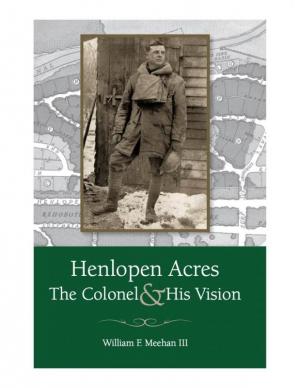Renovating the Henlopen Acres Homestead
William F. Meehan III has published “Henlopen Acres: The Colonel and His Vision.”
Following is an excerpt titled “Wilbur and Louise Corkran’s glorious adventure, Renovating the Homestead.”
When Wilbur and Louise Corkran purchased 180 acres of the Dodd family farm in 1930, about a mile north of Rehoboth Avenue, they acquired the structure that came with the property, the Homestead.
The land, originally deeded in 1675, passed through several owners until 1743, when Peter Marsh took title and built the home called “the mansion house” in subsequent deeds. Marsh was thought to have constructed the Homestead where he did so that he could be nearer to the spot on the beach where according to myth was buried a treasure chest of gold coins.
“But Peter left, as his treasure, not buried, but in the sunlight, something more valuable to us – a house of study [sic], sound design, and honest workmanship,” Louise explained in an article for the American Home magazine. Having been a rental for two decades, the house was in need of a facelift, she said.
“Many storms had passed over, and much living had gone on within its portals before my husband and I came to inspect The Homestead. Little did it seem to merit its name by which it was known in the countryside – a name of warm and vital suggestion. We found it stark and wind-swept, like an old gray high-shouldered, old spinster drawn to herself.”
Louise and Wilbur, known as “the Colonel,” wasted little time renewing the property, he remodeling the Homestead and she overseeing its gardens and the neighborhood landscape design. They would combine their individual talents and undertake a “glorious adventure of bringing this ancient historic shrine up to modern living conditions,” according to Stanley Ross.
When Louise said they obtained material from similarly aged houses in the area, she understated the concerted exercise of her husband and the staff. Ross, writing for the State Sentinel, describes the elaborate endeavor:
“Anxious to retire as closely as possible the house that Peter Marsh had built so well, Col. and Mrs. Corkran scoured the countryside for scores of miles seeking aged cedar shingles of the same type. Every day he would send a carpenter out with a carload of new shingles to ask farmers and backwoods dweller if they’d trade new shingles for old. The townspeople were sure he was a little this side of being crazy, but they gladly made the trade, and every day he acquired a half dozen or so, until not only was he able to replace those missing, but expand the house to twice its size with two new wings, all done in authentic 18th century, 40-inch shingles.”
Ross reported that a representative of the J. B. Van Sciver Furniture Company who was passing through Rehoboth Beach one day asked Corkran if would sell the house. The man said his employer, founded in 1881 and based in Camden, N.J., wanted the black walnut timbers to make furniture and would tear the house down. Corkran said he had no intention of selling the structure.
“Mister, do you know what you’ve got there?” the stranger asked. “I guess so,” the Colonel replied. “I’ve been an engineer and builder for 25 years.”
The Colonel spent a year designing the residential layout in addition to restoring and enlarging the house. In “The Homestead: Peter Marsh’s House,” editor Robert B. Wright points out that once he drew the plans the construction took Corkran only two months. “He was a fast worker,” Wright observed.
Louise, meanwhile, took charge of the horticulture department. “The few remaining hacked and twisted shrubs were torn out, and the beginnings of what is now a paradise of flowers, trees and lawns were planted, with long rows of boxwood, fig trees,” Ross explained.
It was obvious Louise had an affinity with ornamental plants. “Each wildflower,” Gloria Galloway wrote in the Evening Journal, “has its special place in Mrs. Corkran’s heart and she talks of Pseudochorus or ‘Lily of France’ in the same breath with ‘Jack-in-the-Pulpit.’” Louise, for sure, was fastidious about the landscaping and wanted the gardens meticulously maintained.
The Homestead retains much of its original detail and is considered the focal point of the Acres. “Henlopen Acres was, and is, a purely residential area...[and] reflects the architectural and aesthetic character derived from its centerpiece, the Peter Marsh House,” according to application for admission to the National Register of Historic Places, in 1977. Since 1979, the Homestead has served as home for the Rehoboth Art League, the organization founded by Louise Corkran in 1938.



















































